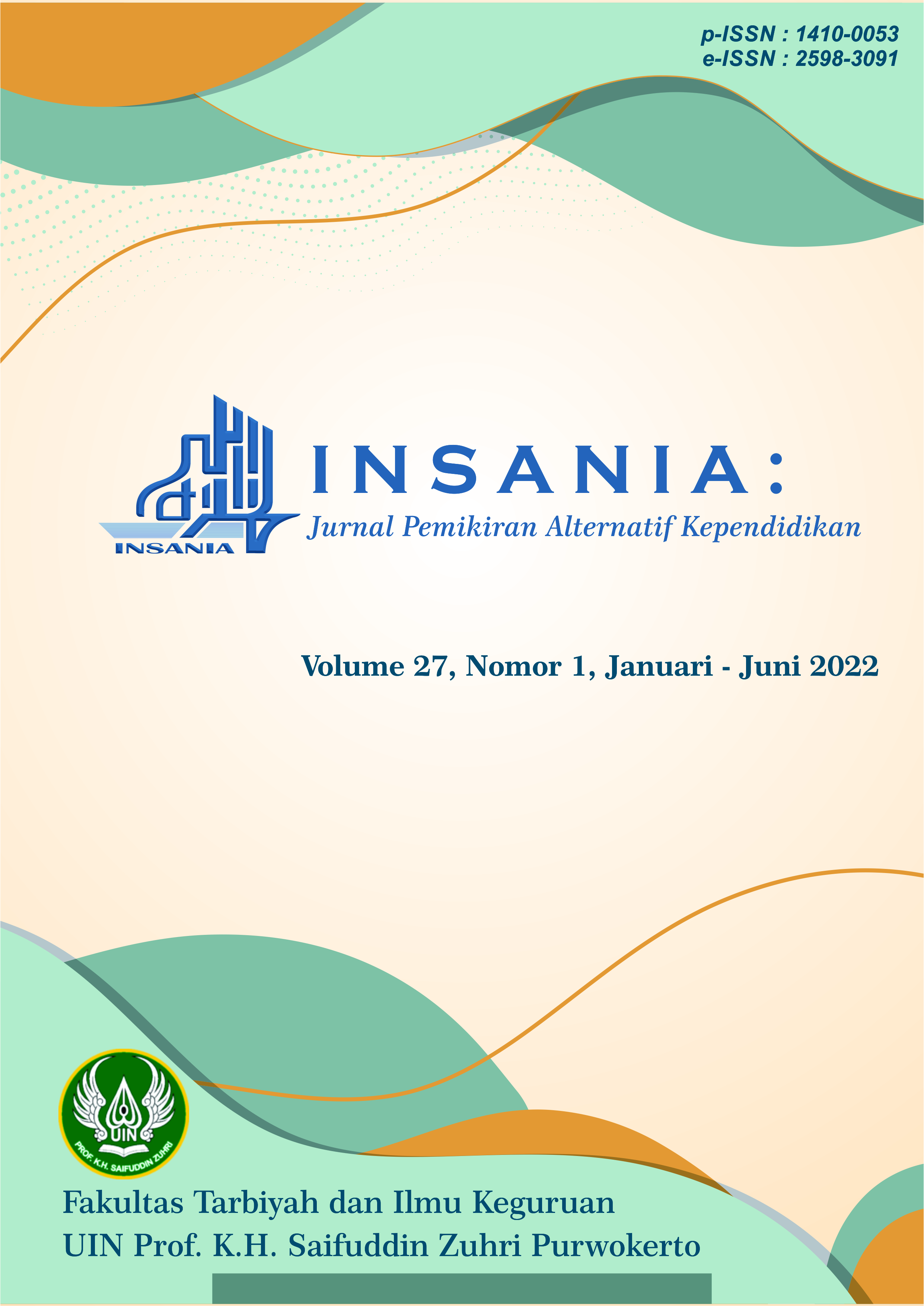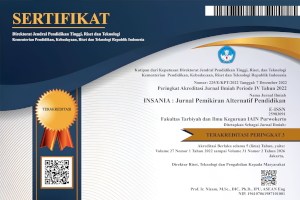Can Humanizing Classroom Meet EFL Learners’ Needs?
DOI:
https://doi.org/10.24090/insania.v27i1.6490Kata Kunci:
EFL, humanizing classroom, learners' needsAbstrak
Humanizing classroom is a learning model which emphasizes the students’ involvement in the classroom and considers the students’ characters, learning style, and background in every phase of teaching-learning activities. This descriptive study investigates the implementation of humanizing classroom practices by high school EFL teachers and looks for the kinds of humanism values being applied as well as their impacts on their pedagogical practices. The subjects of this study were six English teachers at MAN Salatiga. The data is gathered from classroom observation, interviews, and documents. The finding shows that humanizing classroom values is reflected in every aspect and phase of the EFL teaching-learning process, where teachers do not only apply the values during the teaching-learning activities but also in their lesson plan and evaluation. Secondly, positive impacts from the practice exist, proven by the positive feelings shown by the teachers (appreciated) and the students (more confident and comfortable) in their English classes. In addition, when teachers implement the humanizing classroom, students could freely share what they need and feel in the EFL classroom.Unduhan
Referensi
Falchikov, N. (2004). Involving Students in Assessment. Psychology Learning & Teaching, 3(2), 102–108. https://doi.org/10.2304/plat.2003.3.2.102
García-Moya, I., Brooks, F., & Moreno, C. (2020). Humanizing and conducive to learning: An adolescent students’ perspective on the central attributes of positive relationships with teachers. European Journal of Psychology of Education, 35(1), 1–20. https://doi.org/10.1007/s10212-019-00413-z
Ghanizadeh, A., Amiri, A., & Jahedizadeh, S. (2020). Towards Humanizing Language Teaching: Error Treatment and EFL Learners’ Cognitive, Behavioral, Emotional Engagement, Motivation, and Language Achievement. Iranian Journal of Language Teaching Research, 8(1), 129–149.
Hamdan, A. H. E., & Elandeef, E. A. E. (2021). Humanizing Pedagogy: Minimizing Negative Teacher Talking Time on the Teaching of English Language as a Foreign Language. Journal of Literature, Languages and Linguistics, 77, 31–64. https://doi.org/10.7176/JLLL/77-07
Karimi, P., & Sanavi, R. V. (2014). Analyzing English Language Learning Needs among Students in Aviation Training Program. Procedia - Social and Behavioral Sciences, 98, 852–858. https://doi.org/10.1016/j.sbspro.2014.03.491
Koehler, A. A., Newby, T. J., & Besser, E. D. (2017). In the eye of the beholder: Using student narratives to explore memorable teachers. Educational Review, 69(2), 158–180. https://doi.org/10.1080/00131911.2016.1176011
Lacey, A., & Luff, D. (2009). Qualitative Data Analysis. The NIHR RDS for the East Midlands.
Lojova, G. (2016). Humanizing English language teaching in Slovakia. XLinguae, 9(4), 30–36. https://doi.org/10.18355/XL.2016.09.04.30-36
Lozada, R. H. (2020). A Humanistic Theoretical Approach to Educational Research on English Language Teaching. In
E. Sengupta, P. Blessinger, & M. Makhanya (Eds.), Innovations in Higher Education Teaching and Learning (pp. 15–26). Emerald Publishing Limited. https://doi.org/10.1108/S2055-364120200000025002
Mahfud, T., Indartono, S., Saputro, I. N., & Utari, I. (2019). The Effect of Teaching Quality on Student Career Choice: The Mediating Role of Student Goal Orientation. Integration of Education, 23(4), 541–555. https://doi.org/10.15507/1991-9468.097.023.201904.541-555
Maia, A. (2015). Humanizing the Language Classroom. Richmond Share. https://www.richmondshare.com.br/humanizing-the-language-classroom/
Manurung, R. T. (2018). Models of Language Teaching and Humanizing Education. Cakrawala Linguista, 1(1), 14–19. https://dx.doi.org/10.26737/cling.v1i1.493
Mohajan, H. K. (2018). Qualitative Research Methodology in Social Sciences and Related Subjects. Journal of Economic Development, Environment and People, 7(1), 23–48. https://doi.org/10.26458/jedep.v7i1.571
Moriska, U. (2017). Implementasi Model Pembelajaran Humanizing the Classroom dalam Interasi Edukatif Siswa di Madrasah Ibtidaiyah Daarul Aitam Palembang [Undergraduate Thesis, Universitas Islam Negeri Raden Fatah Palembang]. http://repository.radenfatah.ac.id/3114/
Muthmainnah, M., Aeni, N., Galal, M., Varghese, K. J., Castillo, F. D., & Ghofur, Abd. (2021). The Students’ Needs in Developing EFL Materials ICT Based. OKARA: Jurnal Bahasa & Sastra, 15(2), 235–247. https://doi.org/10.19105/ojbs.v15i2.4679
Nagro, S. A., Fraser, D. W., & Hooks, S. D. (2019). Lesson Planning With Engagement in Mind: Proactive Classroom Management Strategies for Curriculum Instruction. Intervention in School and Clinic, 54(3), 131–140. https://doi.org/10.1177/1053451218767905
Nwafor, N. H. A., & Nwogu, U. J. (2014). Humanising the Classroom: A Pragmatic Approach. European Scientific Journal, 10(19), 412–425. https://doi.org/10.19044/esj.2014.v10n19p%25p
Panggabean, H. (2015). Problematic Approach to English Learning and Teaching: A Case in Indonesia. English Language Teaching, 8(3), 35–45. https://doi.org/10.5539/elt.v8n3p35
Poedjiastutie, D., & Oliver, R. (2017). English Learning Needs of ESP Learners: Exploring Stakeholder Perceptions at an Indonesian University. TEFLIN Journal - A Publication on the Teaching and Learning of English, 28(1), 1–21. https://doi.org/10.15639/teflinjournal.v28i1/1-21
Price, J. N., & Osborne, M. D. (2000). Challenges of Forging a Humanizing Pedagogy in Teacher Education. Curriculum and Teaching, 15(1), 27–51. https://doi.org/10.7459/ct/15.1.03
Rahmanpanah, hossein, & Mohseni, A. (2017). Engagement and Motivation in EFL Classroom: Humanizing the Coursebook or Autonomy-supportive Teaching Climate?. Journal of Language and Translation, 7(1), 69–88.
Sadeghi, B., Hassani, M. T., & Hessari, A. D. (2014). On the Relationship between Learners’ Needs and their Use of Language Learning Strategies. Procedia - Social and Behavioral Sciences, 136, 255–259. https://doi.org/10.1016/j.sbspro.2014.05.324
Shih, Y. H. (2018). Towards a Pedagogy of Humanizing Child Education in Terms of Teacher-Student Interaction. Journal of Education and Learning, 7(3), 197-202. https://doi.org/10.5539/jel.v7n3p197
Soviyah, S. (2007). Humanistic Approach in Action: EFL Writing Class. TEFLIN Journal, 18(2), 148–158. http://dx.doi.org/10.15639/teflinjournal.v18i2/148-158
Sun, H. L., Sun, T., Sha, F. Y., Gu, X. Y., Hou, X. R., Zhu, F. Y., & Fang, P. T. (2022). The Influence of Teacher–Student Interaction on the Effects of Online Learning: Based on a Serial Mediating Model. Frontiers in Psychology, 13, 1–10. https://doi.org/10.3389/fpsyg.2022.779217
Suyatno, & Wantini. (2018). Humanizing the Classroom: Praxis of Full Day School System in Indonesia. International Education Studies, 11(4), 115–125. https://doi.org/:10.5539/ies.v11n4p115
Unduhan
Diterbitkan
Cara Mengutip
Terbitan
Bagian
Lisensi
Authors who publish with this journal agree to the following terms:
Authors retain copyright and grant the journal right of first publication with the work simultaneously licensed under a Creative CommonsAttribution-ShareAlike License that allows others to share the work with an acknowledgment of the work's authorship and initial publication in this journal.
Authors are able to enter into separate, additional contractual arrangements for the non-exclusive distribution of the journal's published version of the work (e.g., post it to an institutional repository or publish it in a book), with an acknowledgment of its initial publication in this journal.
Authors are permitted and encouraged to post their work online (e.g., in institutional repositories or on their website) prior to and during the submission process, as it can lead to productive exchanges, as well as earlier and greater citation of published work (See The Effect of Open Access).









